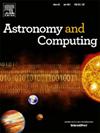The influence of spin in black hole triplets
IF 1.8
4区 物理与天体物理
Q2 ASTRONOMY & ASTROPHYSICS
引用次数: 0
Abstract
Spin can influence the dynamics of the already chaotic black hole triplet system. We follow this problem in two sets of simulations: first, the Agekian–Anosova region (or region D), and second, using Pythagorean triangles. We use ARCcode, an N-body code that performs numerical integration of orbits. This code includes post-Newtonian corrections, which we include up to the 2.5th order. In set one of our simulations, we fix the masses of the black holes at 106 M. Then we run the simulations first without any spin added and after by initialising spin on one of the black holes. We find that after including spin into the system, 12.9% of the simulations changed outcomes. Either the systems went from having all black holes merging to having a black hole escaping the system, or vice versa. In the second set of simulations, we expanded into Pythagorean triangles as initial positions of black holes, stemming from Burrau’s three-body problem. We varied the masses of the black holes from 100 M–1012 M. Black holes in these systems were given spin in normalised units ranging from 0 to 0.95. We find that intermediate mass black holes in the range of 104 M–105 M, were influenced the most by spin, particularly in their lifetimes. We also find that simulations, initialised as 2-dimensional, become 3-dimensional.
黑洞三重体中自旋的影响
自旋可以影响已经混乱的黑洞三重态系统的动力学。我们在两组模拟中跟踪这个问题:第一组,agkian - anosova区域(或区域D),第二组,使用毕达哥拉斯三角形。我们使用ARCcode,一个n体代码,执行轨道的数值积分。这个代码包含了后牛顿修正,我们包含了2.5阶修正。在第一组模拟中,我们将黑洞的质量固定为106 M⊙。然后我们首先在没有添加任何自旋的情况下运行模拟,然后在其中一个黑洞上初始化自旋。我们发现,在系统中加入自旋后,12.9%的模拟改变了结果。要么系统从所有黑洞合并变成一个黑洞逃离系统,要么反之。在第二组模拟中,我们将毕达哥拉斯三角形扩展为黑洞的初始位置,源于伯劳的三体问题。我们改变了黑洞的质量从100m⊙到1012m⊙。这些系统中的黑洞被赋予了归一化单位范围从0到~ 0.95的自旋。我们发现在104m⊙- 105m⊙范围内的中等质量黑洞受自旋的影响最大,特别是在它们的生命周期内。我们还发现,模拟,初始化为二维,变成三维。
本文章由计算机程序翻译,如有差异,请以英文原文为准。
求助全文
约1分钟内获得全文
求助全文
来源期刊

Astronomy and Computing
ASTRONOMY & ASTROPHYSICSCOMPUTER SCIENCE,-COMPUTER SCIENCE, INTERDISCIPLINARY APPLICATIONS
CiteScore
4.10
自引率
8.00%
发文量
67
期刊介绍:
Astronomy and Computing is a peer-reviewed journal that focuses on the broad area between astronomy, computer science and information technology. The journal aims to publish the work of scientists and (software) engineers in all aspects of astronomical computing, including the collection, analysis, reduction, visualisation, preservation and dissemination of data, and the development of astronomical software and simulations. The journal covers applications for academic computer science techniques to astronomy, as well as novel applications of information technologies within astronomy.
 求助内容:
求助内容: 应助结果提醒方式:
应助结果提醒方式:


